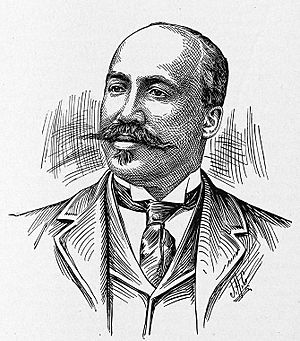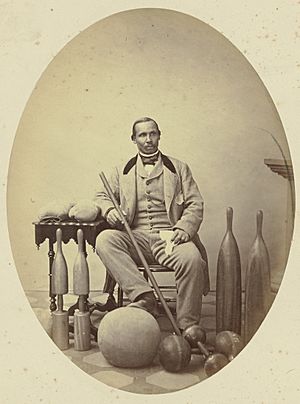Emanuel D. Molyneaux Hewlett facts for kids
Quick facts for kids
Emanuel D. Molyneaux Hewlett
|
|
|---|---|
 |
|
| Born | November 15, 1850 Brooklyn, New York
|
| Died | September 19, 1929 (aged 78) Washington, DC
|
| Nationality | American |
| Alma mater | Boston University School of Law |
| Occupation | Attorney, Judge, Activist |
| Years active | 1877–1929 |
| Known for | One of the first African-American attorneys admitted to the United States Supreme Court bar; first African-American Justice of the Peace in Washington, DC |
| Parents |
|
| Relatives | Virginia Hewlett Douglass (sister) |
Emanuel D. Molyneaux Hewlett (born November 15, 1850 – died September 19, 1929) was an important American lawyer, judge, and activist for civil rights. He was one of the very first African Americans allowed to practice law before the U.S. Supreme Court in 1883. He also became one of the first to argue cases there. From 1890 to 1906, he served as a Justice of the Peace in Washington, DC.
Contents
Early Life and Family
Growing Up in the Hewlett Family
Emanuel Hewlett was born in Brooklyn, New York, on November 15, 1850. His parents were Aaron Molyneaux Hewlett and Virginia Josephine Molyneaux Hewlett. He had two sisters, Virginia and Aaronella, and two brothers, Aaron and Paul. Paul became a Shakespearean actor, using the stage name "Paul Molyneaux."
Emanuel's parents, Aaron and Virginia, were very involved in the "physical culture" movement of the 1800s. This movement focused on staying healthy and fit through exercise. In 1854, Aaron Hewlett opened a boxing school in Brooklyn. The next year, his family moved to Worcester, Massachusetts, where he opened a popular gym.
Parents' Work and Activism
In 1859, Aaron Hewlett became the first director of Harvard College's new gym. He worked there for 14 years, teaching gymnastics, baseball, rowing, and boxing. He also coached sports teams and managed the gym's equipment. Virginia Hewlett was also a gymnastics teacher, holding classes for women. They even ran a gym together in Cambridge, Massachusetts.
Aaron Hewlett was a strong fighter for civil rights for African Americans. He challenged unfair treatment in public places. For example, in 1866, he and his daughter were forced to sit in the balcony at the Boston Theater, even though they had bought tickets for better seats. He asked for changes to Massachusetts' anti-discrimination laws. In 1868, he helped a group try to stop a Cambridge skating rink's license because it discriminated against Black people. That same year, he helped start the Cambridge Land and Building Association. This group gave loans to African Americans who couldn't get help from white-run banks.
Emanuel's Education
Emanuel Hewlett went to public schools in Cambridge and graduated from Cambridge High School. He then studied at Boston University School of Law. In 1877, he became the first Black person to graduate from that law school.
Legal Career and Justice Work
Starting as a Lawyer
Hewlett practiced law in Boston from 1877 to 1880. After that, he moved to Washington, DC. In 1883, he was allowed to practice law before the United States Court of Claims and the U.S. Supreme Court. Being admitted to the Supreme Court bar meant he could argue cases in the highest court in the country.
In 1890, President Benjamin Harrison appointed Hewlett as a justice of the peace for Washington, DC. Presidents Cleveland, McKinley, and Theodore Roosevelt reappointed him. He served a total of 16 years. Justices of the peace handled "poor man's courts." These courts dealt with smaller civil cases involving less than $300. This was a very important job for a Black lawyer at that time. In 1906, the number of justices of the peace was reduced. Hewlett was not reappointed, which some Black newspapers believed was a political decision.
Fighting for Equal Rights in Court
As a lawyer for the Supreme Court, Hewlett worked on ten cases. He often joined appeals for Black defendants from the South. He also recommended other African American lawyers to join the Supreme Court bar.
Many of the cases Hewlett worked on tried to make sure the Reconstruction amendments to the Constitution were followed. These amendments were meant to give equal rights to all citizens. Hewlett argued that Black defendants' civil rights were violated. This often happened when African Americans were unfairly kept off juries.
For example, in cases like Charley Smith v. State of Mississippi (1896) and John G. Gibson v. State of Mississippi (1896), Hewlett argued that the juries were unfair. He said they were chosen from lists that excluded Black citizens. The court dismissed these cases, saying there wasn't enough proof of unfairness. In Brownfield v. North Carolina (1903), he made similar arguments but again, the court said there wasn't enough evidence.
However, in Carter v. Texas (1900), Hewlett had some success. He argued that Seth Carter's murder charge should be dropped. This was because no Black people were chosen for the grand jury, even though Black people made up a quarter of voters in Galveston, Texas. The court agreed, but their decision was mainly about how the jury was chosen, not just about race. This case was still a step forward for the idea that Black defendants should have Black people on their juries.
Activism Through Law
Hewlett also used his legal skills to fight against racism and discrimination in other ways. He filed many cases when Black people were denied access to public places. In 1884, he sued a steamboat clerk who refused to give him the meal his ticket allowed. The case was dismissed.
In 1889, Hewlett represented George L. Pryor, a Black lawyer. Pryor had been seated at the back of a theater even though he bought tickets for better seats. In 1900, Hewlett also helped in a similar case against the Grand Opera House.
Hewlett and other Black citizens in Washington, DC, used the courts to fight against restaurants and bars that broke local laws. These laws, called the Equal Services Acts of 1872 and 1873, said that businesses could not discriminate based on race. Some places would refuse to serve Black customers or overcharge them. In 1887, Hewlett complained against Harvey's Oyster House for denying him service. The restaurant was fined but appealed, and the case was eventually dropped. In 1907, he reported a lunchroom in the city hall that refused to serve him and a Black colleague. The lunchroom operator then closed the restaurant, saying her white customers would not share the space with Black people.
Hewlett also dealt with the issue of interracial marriage as a justice of the peace. In 1902, he married Julia Johnson and George Wilson from Baltimore. They came to Washington because their home state of Maryland did not allow interracial marriages.
Community and Civil Rights Work
Business Ventures
Besides his work as a lawyer and judge, Hewlett was involved in real estate and insurance businesses. These included the Alpha Law, Real Estate and Collection Company (1892) and the Douglass Life Insurance Company (1901). These companies were important because white-run businesses often would not work with Black customers. Hewlett's firms provided needed services to the Black community.
Fighting for Civil Rights
Hewlett was a member of many civil rights groups that started around the early 1900s. These groups worked to make sure the 13th, 14th, and 15th amendments were followed. They also fought against discrimination, segregation (keeping races separate), and the unfair Jim Crow laws. Hewlett often served as a legal advisor for these groups.
In 1898, he helped start the National Racial Protective Association and the Afro-American Council. In the 1910s and 1920s, he was very active in the National Equal Rights League. During World War I, he joined protests in Washington, DC, against the unfair treatment of African American soldiers.
Personal Life
Emanuel Hewlett did not marry until later in his life and had no children of his own. By 1900, he was living with Elizabeth P. Brooks, a widow. Hewlett and Brooks married on August 14, 1920. In 1890, after his sister Virginia Hewlett Douglass passed away, he became the guardian for her two young children, Charles Paul Douglass and Robert Smalls Douglass. Virginia Hewlett Douglass was the daughter-in-law of the famous abolitionist Frederick Douglass.
Elizabeth Hewlett died in July 1926. Emanuel Hewlett passed away on September 19, 1929. He was buried at Columbian Harmony Cemetery in Washington, DC.


